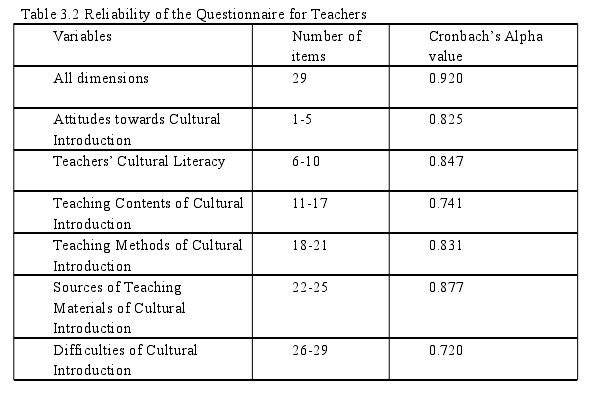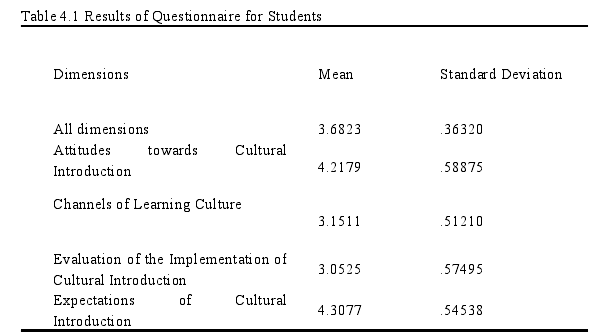本文是一篇英语毕业论文,笔者认为英语教师对文化导入的正确理解至关重要。高中英语教师应认识到文化与语言的相关性,加强文化教学与语言教学的结合。然而,英语教师往往忽视语言与文化的相互关系,总是将文化与课堂语言教学相分离。这也是为什么大多数教师抱怨有限的课程时间是文化引进的障碍。
Chapter One Introduction
1.1 Background of the Research
Due to the fast development of economy and the Internet as well as China’s risinginternational status, higher requirements have been put forward towards people’sintercultural literacy. In modern times, English, as a lingua franca, has been widely usedin formal occasions. Especially, since the “Belt and Road” Initiative was put forward in2013, cultural issues have drawn great attention. Thus, new demands have been broughtabout conducting cultural introduction in English class.
Besides, the researches of cultural introduction in English class are in a growingnumber. For instance, Shu Dingfang (1996:14) states that the inseparable relationshipbetween English teaching and cultural introduction has become a focus. As Wen Qiufang(2016:6) points out, globalization requires English teachers to lay more stress onintroduction of different cultures, including target culture, native culture and other foreigncultures. In Jiang Hongxin et al’s view (2020), under the multicultural environment,talents with great language skills and knowledge as well as great cultural literacy are stilllimited. Considering this, they propose that students are required to possess the ability tounderstand different life styles, thinking modes and customs of different countries.Consequently, it is quite necessary to make a research about cultural introduction insenior high schools.
In addition, it is also the requirements of new curriculum reform of English teachingto conduct cultural introduction. National English Curriculum Standards for Senior HighSchool (2017 Edition, Revised in 2020) emphasizes the significance of cultural teaching.It highlights the cultivation of culture awareness, which is also one of the key competencein English subject. Besides, National English Curriculum Standards for Senior HighSchool (2017 Edition, Revised in 2020) also suggests that students are supposed tounderstand and absorb excellent cultures of China and other countries, helping cultivatetheir open and inclusive attitudes to the world as well as their comprehensively intercultural communication competence. Further, it is also mentioned that culturalintroduction is conducive to students’ improvement of cultural self-confidence and theawareness of a great power status of China.
1.2 Purpose of the Research
On the basis of previous researches, the present study aims to explore two questionsin this teaching field. To begin with, two instruments including questionnaires andclassroom observation are adopted to explore the status quo of cultural introduction insenior high schools. Secondly, based on the collected data and interview results, thefactors influencing cultural introduction are hoped to find out in senior high schools. Lastbut not least, according to the findings of these two questions, some correspondingsuggestions will be offered to optimize the implementation of cultural introduction inEnglish class in senior high schools.
Theoretically, the study is of importance to researchers because the necessarypractical data are provided for later theoretical researches of cultural introduction. Thisstudy explores the overall situation and affecting factors of cultural introduction in seniorhigh schools, which can provide persuasive supports for cultural introduction in Englishteaching. In the meantime, this study will also enrich acculturation and interculturalcommunication theory, promoting their further implications in English teaching.
Chapter Two Literature Review
2.1 Description of Language and Culture
A detailed description of language and culture is elaborated in this part, includingdefinition of culture as well as the relationship between language and culture. They arepresented as follows.
2.1.1 Definition of Culture
Some scholars attempt to give “culture” a descriptive definition. For example,Edward Taylor has a profound impact on the definitions of culture. As Taylor (1920) sumsup, civilization and culture should be a synthesis, including knowledge, beliefs, arts,morality, laws, customs and other abilities or habits acquired by individuals. From thisdefinition, it can be concluded that spiritual level rather than the concrete one of theconcept is emphasized.
From the perspective of psychology, Clellan Ford (1942) points out that cultureconsists of traditional responses of solving problems that have been accepted. Thepsychological definition of culture makes clear why culture exists and how it forms, whileit hardly explains what culture is.
Besides, Claire Kramsch also puts forward a representative definition about culture.It is claimed that culture is a portable scheme of interpreting actions and issues whichpeople have gained through junior socialization, which may change because of migratingor encountering with others from different cultures (Kramsch, 2014).
When it comes to the researches of culture in China, some notable definitions ofculture are given.
2.2 Description of Cultural Introduction
A detailed description of cultural introduction is illustrated in this part, consisting ofdefinition and necessities of cultural introduction. They are elaborated clearly as follows.
2.2.1 Definition of Cultural Introduction
Plenty of scholars at home have studied the definition of cultural introduction andsome representative definitions are presented as follows. Chen Guanglei (1992:28)defines “cultural introduction” in this way: learners should be taught about the culturecontained in language and the cultural conventions in foreign language learning, cultivating their intercultural communication competence for future development. Further,Yang Xueyun (2010:129) considers that cultural introduction should be conducted basedon the syllabus and teaching materials, integrating cultural introduction and languageteaching in English class and guiding students to acquire rich native culture as well astarget culture. In another word, students are encouraged to obtain different cultures andimprove their pragmatic competence of language and culture awareness.
Likewise, there are also fruitful studies focusing on the definition of culturalintroduction abroad. According to Stern (1992), cultural teaching is comprised of acognitive component, an affective component and a behavioral component. As for thecognitive component, it means a great deal of knowledge, such as geographicalknowledge and different cultural values. The affective one refers to the attitudes ofcuriosity and empathy for the target culture. And the behavioral component relates to theability of interpreting behaviors with a view of target culture and behaving in a culturallyappropriate way. By the 2010s, cultural introduction is mentioned as an essential part ofEnglish teaching, which aims at cultivating intercultural communication competence,namely the knowledge of a nation and its customs as well as practices (Brdaric, 2016).

Chapter Three Research Design........................................17
3.1 Research Questions................................ 17
3.2 Research Subjects...............................................17
Chapter Four Results and Discussion.....................22
4.1 The Current Situation of Cultural Introduction in English Class in Senior HighSchool from the Perspective of Students....................22
4.1.1 Attitudes towards Cultural Introduction.............................23
4.1.2 Channels of Learning Culture................................. 24
Chapter Five Conclusion...................................49
5.1 Major Findings................................... 49
5.2 Suggestions for Cultural Introduction......................................... 50
Chapter Four Results and Discussion
4.1 The Current Situation of Cultural Introduction in English Class inSenior High School from the Perspective of Students
In order to get a clear picture of the current situation of cultural introduction, theanalysis of current situation of cultural introduction is displayed from the perspective ofstudents. It consists of statistical analysis of students’ attitudes towards culturalintroduction, channels of learning culture, evaluation of the implementation of culturalintroduction and expectation of cultural introduction. The followings are detaileddescriptions.

Table 4.1 clearly shows the means and standard deviation of all dimensions and eachdimension of the questionnaire for students. Overall, as shown in Table 4.1, the mean ofall dimensions is 3.6823 and its standard deviation is 0.36230. It appears to suggest that cultural introduction is at a high level in English class in senior high schools (M≥3.5).However, further analysis reveals that the mean of students’ attitudes towards culturalintroduction is 4.2179, and its standard deviation is 0.58875. Its mean is higher than thatof all dimensions, indicating that students have a positive attitude towards culturalintroduction. Moreover, the mean of students’ expectation of cultural introduction is4.3077 and its standard deviation is 0.54538. The mean of this dimension ranks the top,which shows the students’ strong expectation for cultural introduction. However, whenlooking carefully at channels of learning culture, its mean is 3.1511 and the standarddeviation is 0.51210.
Chapter Five Conclusion
5.1 Major Findings
This study aims to find out the current situation of cultural introduction as well asthe factors influencing cultural introduction in English class in senor high schools. Andthe major findings of the study are presented as follows.
On one hand, the findings of the current situation are presented from the perspectiveof both teachers and students. For one thing, from the perspective of students, in total, itcan be concluded that they are not so satisfied with the current cultural introduction. To bespecific, on the basis of the questionnaire data and the observation results, it can beconcluded that students show great interest in cultural introduction. Nevertheless, theyhave few accesses to learn culture, mainly through textbooks and their teachers. Inaddition, students appear to deem that teachers pay less attention to cultural introductionin English class. In general, students expect to acquire more cultural knowledge andguidance about extracurricular cultural reading from their teachers. Further, it is hopedthat more channels can be provided to learn culture. For another, according to the resultsof the questionnaire for teachers present that most teachers have a positive attitudetowards cultural introduction, admitting the great significance of cultural introduction inEnglish class. However, by comparing the observation results and interview results, it isfound that teachers tend to lack emphasis on conducting cultural introduction in the class,which is mainly manifested in two aspects. The first aspect is that the cultural contentsmentioned in English class are not rich enough. And another aspect is that their teachingmethods are not diversified. Besides, it can be concluded that teachers’ cultural literacy isstill poor. Further, they deem that few sources to obtain cultural teaching materials areprovided. Furthermore, as for the difficulties, four obstacles are recognized, namely,limited time in English class, insufficient training of cultural teaching, fewer sources tofind appropriate teaching materials as well as their poor cultural literacy.
reference(omitted)
